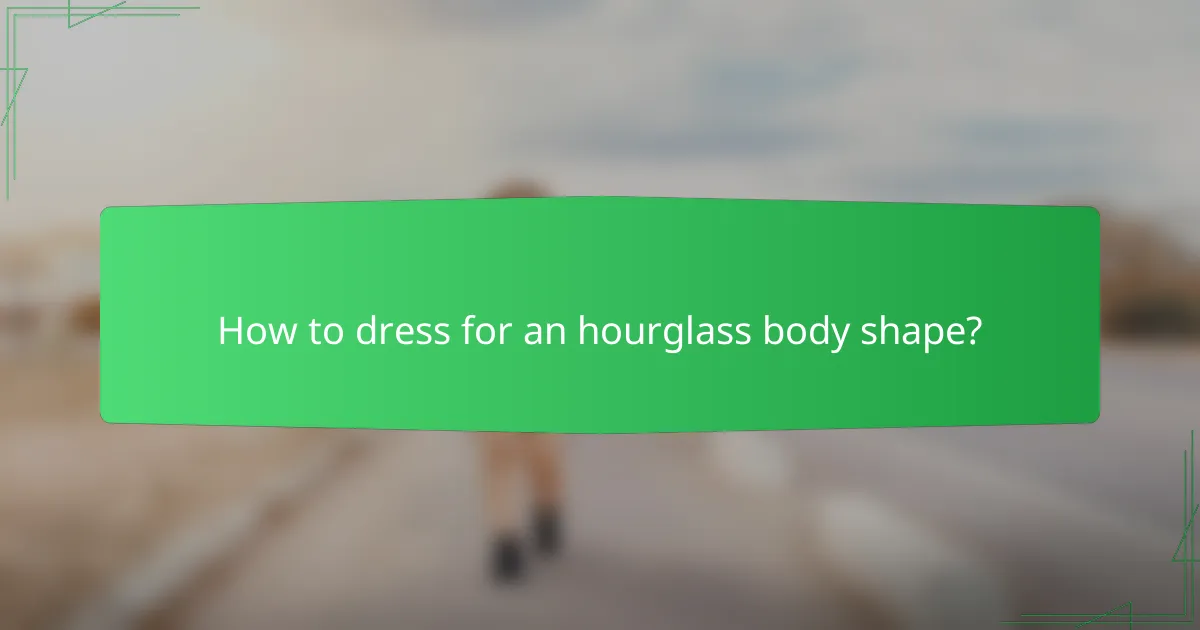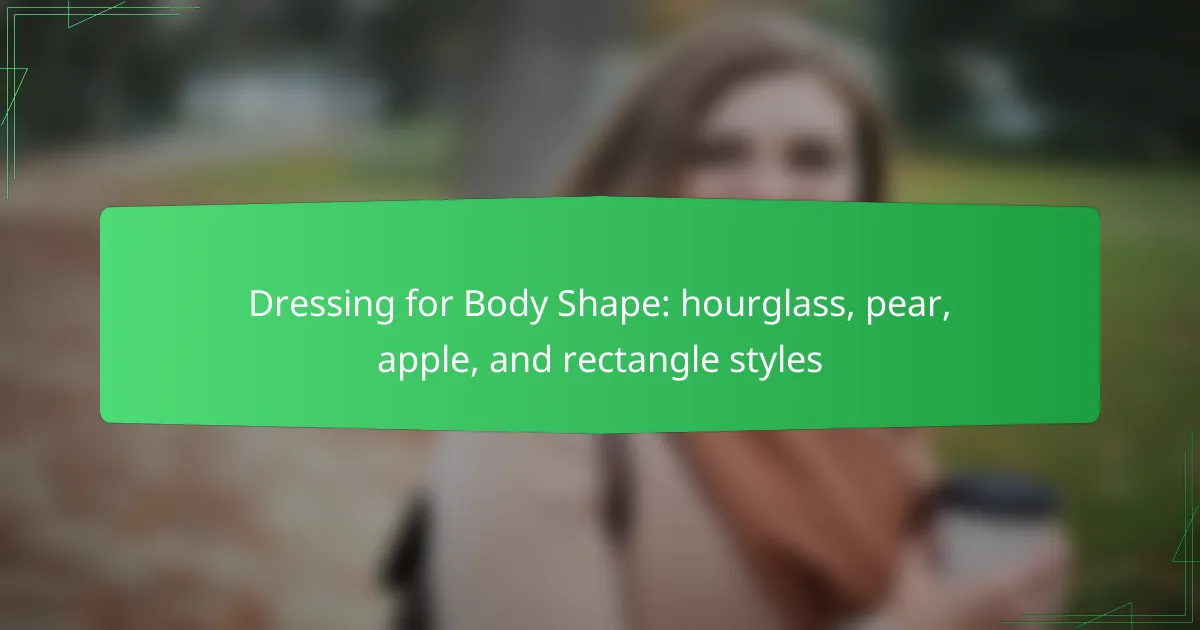Understanding how to dress for your body shape can enhance your natural beauty and boost your confidence. Whether you have an hourglass, pear, apple, or rectangle shape, choosing the right styles can help you highlight your best features and achieve a balanced silhouette. By focusing on key elements like waist definition and proportion, you can create outfits that flatter your unique figure.

How to dress for an hourglass body shape?
Dressing for an hourglass body shape involves accentuating the curves while maintaining balance. Focus on fitted clothing that highlights the waist and complements the bust and hips.
Fitted tops and dresses
Choose fitted tops and dresses that hug the body without being overly tight. Look for styles that enhance your bust and taper at the waist, such as wrap dresses or tailored blouses. Fabrics with a bit of stretch can provide comfort while still showcasing your shape.
Avoid boxy or oversized tops, as they can hide your natural curves. Instead, opt for V-necks or scoop necklines that draw attention to your upper body.
High-waisted bottoms
High-waisted bottoms are ideal for hourglass figures as they emphasize the waist and elongate the legs. Consider high-waisted skirts, trousers, or jeans that fit snugly at the waist and flare out slightly at the hips.
Steer clear of low-rise styles, which can disrupt the natural silhouette. Instead, look for bottoms with a tailored fit that provide a smooth line from waist to hip.
Defined waistlines
Defined waistlines are crucial for hourglass shapes. Incorporate belts, peplum tops, or dresses with built-in waist definition to enhance your figure. This creates a balanced look that highlights your curves.
Avoid shapeless garments that lack structure, as they can obscure your waist. Instead, choose pieces that intentionally define this area, ensuring a flattering and polished appearance.

What styles suit a pear body shape?
For a pear body shape, styles that highlight the waist while balancing the proportions of the hips are ideal. This includes clothing that draws attention upward and creates a more defined silhouette.
A-line skirts
A-line skirts are perfect for pear-shaped bodies as they gently flare out from the waist, providing a flattering fit. This style helps to skim over the hips and thighs, creating a balanced look. Opt for skirts that hit just above the knee to elongate the legs while maintaining comfort.
Off-the-shoulder tops
Off-the-shoulder tops are an excellent choice for pear shapes, as they draw attention to the shoulders and neckline. This style creates a wider upper body appearance, which helps to balance the proportions of the hips. Look for tops with ruffles or embellishments to enhance this effect.
Dark-colored bottoms
Wearing dark-colored bottoms can help streamline the lower body, making it appear slimmer. Choose dark jeans or trousers that fit well and provide a smooth silhouette. Pairing these with lighter or brighter tops can further emphasize the waist and create a more harmonious overall look.

How to choose outfits for an apple body shape?
For an apple body shape, focus on outfits that create balance and define the waist while drawing attention to the neckline and legs. Opt for styles that provide structure and flow, helping to elongate the torso and create a flattering silhouette.
Empire waist dresses
Empire waist dresses are ideal for apple body shapes as they cinch just under the bust, allowing for a flowing skirt that skims over the midsection. Look for dresses that have a defined waistline to create an hourglass effect without clinging to the stomach area. Fabrics like cotton or jersey can add comfort while maintaining a stylish appearance.
V-neck tops
V-neck tops are a great choice for apple shapes as they elongate the neck and draw attention upward, creating a more balanced look. Choose tops with a slight stretch to ensure they fit well without being too tight around the midsection. Pair these with tailored trousers or skirts to enhance your overall silhouette.
Flowy fabrics
Flowy fabrics are essential for apple body shapes, as they provide movement and comfort without adding bulk. Materials like chiffon or lightweight cotton can help create a soft, flattering drape that conceals any areas of concern. Avoid overly structured or stiff fabrics that may restrict movement or highlight unwanted areas.

What are the best styles for a rectangle body shape?
For a rectangle body shape, the best styles are those that create the illusion of curves and define the waist. Look for outfits that add volume to the bust and hips while cinching at the waist to enhance your silhouette.
Layered outfits
Layering can add dimension to a rectangle body shape. Consider wearing a fitted top under a loose cardigan or a structured jacket to create a more defined waistline. Pairing a flowy blouse with tailored trousers can also introduce curves without overwhelming your frame.
Mixing textures and lengths can enhance the layered look. For example, a longer outer layer over a shorter top can create visual interest and shape. Aim for a balance between fitted and loose pieces to maintain a flattering silhouette.
Belts to create curves
Using belts is an effective way to create curves on a rectangle body shape. Opt for wide belts that can cinch the waist, drawing attention to this area and creating an hourglass effect. A belt worn over a dress or a loose top can instantly transform your look.
Experiment with different styles and colors of belts to find what works best for you. A contrasting belt can define your waist even more, while a matching belt can provide a seamless look. Avoid overly thin belts, as they may not provide the desired effect.
Structured blazers
Structured blazers are ideal for enhancing a rectangle body shape. Look for blazers with defined shoulders and a tailored fit that can create a more feminine silhouette. A blazer that nips in at the waist can help to emphasize your curves.
Pair structured blazers with fitted tops and skirts or trousers to maintain a polished appearance. Choose blazers with interesting details, such as peplum styles or embellishments, to add visual interest and further define your shape.

What are the key considerations for dressing in Canada?
Dressing in Canada requires attention to seasonal changes, fabric choices, and layering techniques to stay comfortable and stylish. Understanding the diverse climate across regions helps in selecting appropriate outfits that suit both the weather and personal body shape.
Seasonal fabric choices
Selecting the right fabrics is crucial for dressing in Canada, where temperatures can vary significantly throughout the year. In winter, opt for heavier materials like wool and fleece for warmth, while lighter fabrics such as cotton and linen are ideal for summer months. Consider moisture-wicking fabrics for transitional seasons to manage temperature fluctuations.
For spring and fall, layering with breathable materials can help regulate body temperature. Fabrics like merino wool and blends that include synthetics offer versatility and comfort during these in-between seasons.
Layering techniques
Layering is an effective strategy for adapting to Canada’s unpredictable weather. Start with a moisture-wicking base layer to keep sweat away from your skin, followed by an insulating layer such as a sweater or fleece. Finally, add an outer layer like a waterproof jacket to protect against rain or snow.
When layering, aim for a balanced silhouette that flatters your body shape. For instance, if you have an hourglass figure, a fitted base layer can accentuate your waist, while a structured outer layer can provide shape without adding bulk.
Weather-appropriate styles
Choosing weather-appropriate styles is essential for comfort and functionality. In winter, prioritize insulated coats, thermal leggings, and waterproof boots to navigate snow and ice. In contrast, summer styles should include breathable dresses, shorts, and sandals to keep cool during warm days.
For transitional weather, versatile pieces like cardigans or light jackets can be easily added or removed. Accessories such as scarves and hats not only enhance style but also provide additional warmth when needed.

How to mix and match styles for different body shapes?
Mixing and matching styles for various body shapes involves understanding how different cuts and silhouettes complement your figure. By selecting the right combinations, you can enhance your natural shape and create a balanced look.
Combining fitted and loose pieces
To achieve a flattering outfit, pair fitted pieces with looser items. For example, if you have an hourglass shape, try a fitted top with a flowy skirt to highlight your waist while providing comfort. Conversely, for a pear shape, a loose top can balance out fitted bottoms, creating a harmonious silhouette.
When mixing fitted and loose styles, consider the proportions. A general rule is to keep one piece fitted and the other loose to avoid overwhelming your frame. Experiment with different lengths and fabrics to find combinations that work best for your body shape.
Accessorizing for balance
Accessories can play a crucial role in balancing your outfit. For instance, if you have an apple shape, opt for long necklaces that draw attention downwards, creating an elongated appearance. Conversely, if you are a rectangle shape, use statement belts to define your waist and add curves.
When choosing accessories, think about scale and placement. Large accessories can overwhelm smaller frames, while delicate pieces may get lost on larger figures. Aim for a mix that complements your outfit and enhances your natural proportions.
